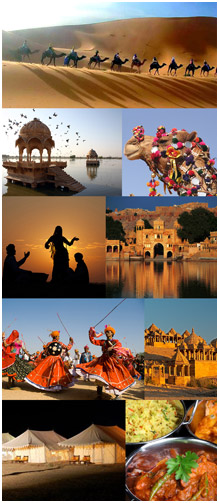 Although located in a barren desert called Thar, Jaisalmer is still both exotic and captivating. It was once prosperous because of its location near to camel routes, and now it is a highly popular tourist destination known as “The Golden City” because of the sandstone used in the buildings, especially the prominent fort above the city. You might find yourself imagining yourself in Arabian Nights when navigating through the maze of streets here. The History of Jaisalmer is as charming as the city, drawing heavily from the history of the Rajputana. The city is said to be founded by Raja Rawal Jaisal, a Bhatti Rajput ruler, in approximately 1156 A D. Legends go by that he did it on the behest of a local hermit named Eesaal. The raja choose Trikut hill as the new site for his fort. This was because he thought that his home at Luderwa was vulnerable to attack. In medieval times, Jaisalmer attracted many people because of its location between two trade routes that connected India to Persia, Egypt, Africa and the west. The Bhatti Rajput rulers collected a lot of wealth through taxes on the passing caravans. For many years Jaisalmer remained out of bound from the foreign rulers partly because of its location and partly because of its relief. In the mid Thirteenth century, Ala-ud-din Khilji, the Turk-Afghan ruler of Delhi laid the siege over the city. He was apparently upset with the Bhatti Rajput rulers because they stopped and looted one of his caravans containing royal. The battle lasted for approximately 9 years. The city also had problems with the Mughal rulers in Delhi. In the modern era, Jaisalmer was still tough-hearted and was the last of the Rajputana royals to sign the ‘Instrument of Agreement’ with the British. In the year 1947, royals signed the agreement to remain in independent India. Since then it has developed itself into a major tourist destination as well as a cultural center.
Although located in a barren desert called Thar, Jaisalmer is still both exotic and captivating. It was once prosperous because of its location near to camel routes, and now it is a highly popular tourist destination known as “The Golden City” because of the sandstone used in the buildings, especially the prominent fort above the city. You might find yourself imagining yourself in Arabian Nights when navigating through the maze of streets here. The History of Jaisalmer is as charming as the city, drawing heavily from the history of the Rajputana. The city is said to be founded by Raja Rawal Jaisal, a Bhatti Rajput ruler, in approximately 1156 A D. Legends go by that he did it on the behest of a local hermit named Eesaal. The raja choose Trikut hill as the new site for his fort. This was because he thought that his home at Luderwa was vulnerable to attack. In medieval times, Jaisalmer attracted many people because of its location between two trade routes that connected India to Persia, Egypt, Africa and the west. The Bhatti Rajput rulers collected a lot of wealth through taxes on the passing caravans. For many years Jaisalmer remained out of bound from the foreign rulers partly because of its location and partly because of its relief. In the mid Thirteenth century, Ala-ud-din Khilji, the Turk-Afghan ruler of Delhi laid the siege over the city. He was apparently upset with the Bhatti Rajput rulers because they stopped and looted one of his caravans containing royal. The battle lasted for approximately 9 years. The city also had problems with the Mughal rulers in Delhi. In the modern era, Jaisalmer was still tough-hearted and was the last of the Rajputana royals to sign the ‘Instrument of Agreement’ with the British. In the year 1947, royals signed the agreement to remain in independent India. Since then it has developed itself into a major tourist destination as well as a cultural center.
